Discover 35 hidden attractions, cool sights, and unusual things to do in San Antonio (United States). Don't miss out on these must-see attractions: The Alamo, Institute of Texan Cultures, and San Antonio Missions National Historical Park. Also, be sure to include Tower of the Americas in your itinerary.
Below, you can find the list of the most amazing places you should visit in San Antonio (Texas).
Table of Contents
The Alamo

Legendary fort and Texas-history museum. The Alamo Mission, commonly called the Alamo and originally known as the Misión San Antonio de Valero, is a historic Spanish mission and fortress compound founded in the 18th century by Roman Catholic missionaries in what is now San Antonio, Texas, United States. It was the site of the Battle of the Alamo in 1836, where American folk heroes James Bowie and Davy Crockett died. Today it is a museum in the Alamo Plaza Historic District and a part of the San Antonio Missions World Heritage Site.
The historic district was one of the early Spanish missions in Texas, built for the education of local American Indians after their conversion to Christianity. The mission was secularized in 1793 and then abandoned. Ten years later, it became a fortress housing the Second Flying Company of San Carlos de Parras military unit, who likely gave the mission the name Alamo. During the Texas Revolution, Mexican General Martín Perfecto de Cos surrendered the fort to the Texian Army in December 1835, following the Siege of Béxar. A relatively small number of Texian soldiers then occupied the compound for several months. The defenders were wiped out at the Battle of the Alamo on March 6, 1836. As the Mexican Army retreated from Texas several months later, they tore down many of the Alamo walls and burned some of the buildings.
For the next five years, the Alamo was periodically used to garrison soldiers, both Texian and Mexican, but was ultimately abandoned. In 1849, several years after Texas was annexed to the United States, the U.S. Army began renting the facility for use as a quartermaster's depot, before again abandoning the mission in 1876 after nearby Fort Sam Houston was established. The Alamo chapel was sold to the state of Texas, which conducted occasional tours but made no effort to restore it. The remaining buildings were sold to a mercantile company that operated them as a wholesale grocery store.
The Daughters of the Republic of Texas (DRT) formed in 1891 and began trying to preserve the Alamo. Adina Emilia De Zavala and Clara Driscoll successfully convinced the state legislature in 1905 to purchase the remaining buildings and to name the DRT as the permanent custodian of the site. Over the next century, periodic attempts were made to transfer control of the Alamo from the DRT. In early 2015, Texas Land Commissioner George P. Bush officially moved control of the Alamo to the Texas General Land Office. The Alamo and the four missions in the San Antonio Missions National Historical Park were designated a UNESCO World Heritage Site on July 5, 2015.[1]
Address: 300 Alamo Plaza, 78205 San Antonio (Central City)
Institute of Texan Cultures
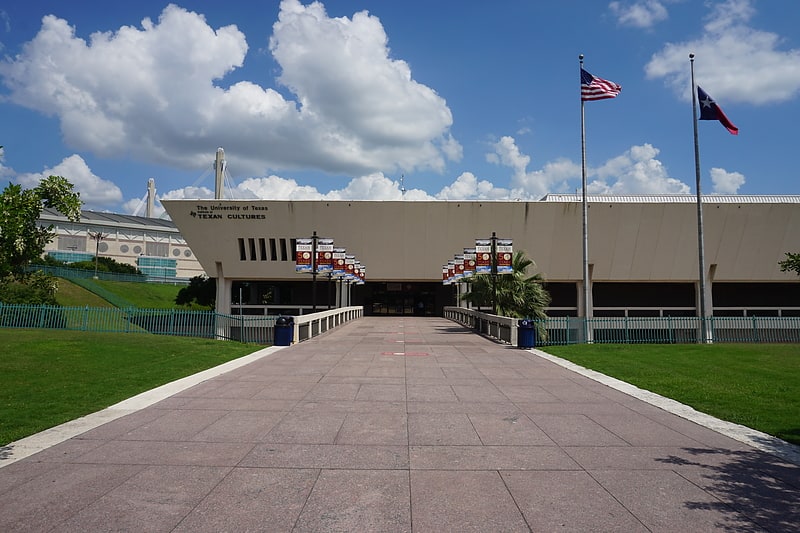
Cultural institute in San Antonio, Texas. The University of Texas at San Antonio Institute of Texan Cultures is a museum and library located in HemisFair Park in Downtown San Antonio, Texas. It serves as the state's primary center for multicultural education, with exhibits, programs, and events like the Texas Folklife Festival, an annual celebration of the many ethnicities that make up the population of Texas. It has been held yearly since 1972.
The facility, established by the Texas Legislature on May 27, 1965, originally served as the Texas Pavilion at HemisFair '68 before being turned over to the University of Texas System in 1969. UTSA assumed administrative control of the museum in 1973. In 1986, the System designated the Institute as a campus of the University of Texas at San Antonio. Now, it is part of UTSA's HemisFair Campus. It is located near the Alamo and the River Walk.
The Institute of Texan Cultures, through its research, collections, exhibits and programs, serves as the forum for the understanding and appreciation of Texas and Texans. The 182,000-square-foot (16,900 m2) complex has 65,000-square-foot (6,000 m2) of interactive exhibits and displays. The library on the third floor contains manuscripts, rare books, personal papers, over 3 million historical photos and over 700 oral histories.
Funding for the museum comes primarily from three sources: biennial legislative appropriations; exhibit floor and special event admissions; grants, contributions, and other locally generated funds such as the rental of the museum's facilities, and the sale of its publications, audiovisuals, library services, and merchandise from The Museum Store. Major support is provided by the museum's Development Board. The Texas Legislature cut appropriations for the institute by 25% in 2011 causing the institute to rely more on private donations and corporate sponsorship.
ITC fulfills its mandate as the state's center for multicultural education by investigating the ethnic and cultural history of the state and presenting the resulting information with a variety of offerings:
- Exhibits, programs, and special events designed to entertain, inspire, and educate
- A library focusing on ethnic and cultural history
- A historical photo collection of more than 3.5 million images
- An outreach program to schools and other groups
- Teacher-training workshops.
There are displays in the museum representing many cultures and their impact on the history and development of Texas.
In early 2010, ITC became an affiliate as part of the Smithsonian Affiliates program. Affiliate status grants the institute access to the Smithsonian’s artifacts, education, and performing arts programs, expert speakers, teacher workshops, and resources to complement and broaden exhibitions. The Affiliation agreement marks a new era for the institute. A series of upgrades are planned to revitalize main exhibit floor. As UTSA strives to achieve national research university status, the University's museum strives to become a cultural institution of equal caliber.[2]
Address: 801 E César E. Chávez Blvd, 78205-3296 San Antonio (Central City)
San Antonio Missions National Historical Park
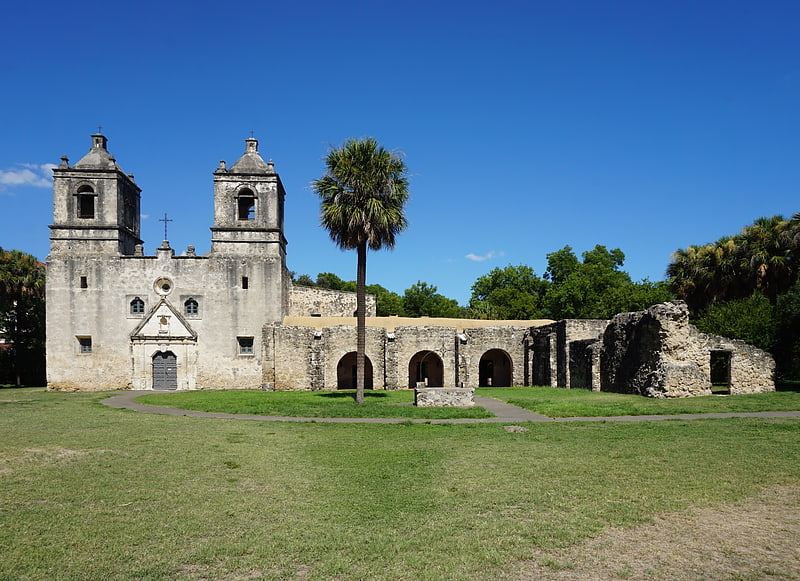
National park in Texas. San Antonio Missions National Historical Park is a National Historical Park and part of a UNESCO World Heritage Site preserving four of the five Spanish frontier missions in San Antonio, Texas, USA. These outposts were established by Catholic religious orders to spread Christianity among the local natives. These missions formed part of a colonization system that stretched across the Spanish Southwest in the 17th, 18th, and 19th centuries.
In geographic order from north (upstream of the San Antonio River) to south (downstream) the missions are Mission Concepción, Mission San Jose, Mission San Juan, and Mission Espada. The Espada Aqueduct, also part of the Park, is due east of Mission San Juan, across the river.
The fifth (and best known) mission in San Antonio, the Alamo, is not part of the Park. It is located upstream from Mission Concepción, in downtown San Antonio, and is owned by the State of Texas. The Alamo was operated by the Daughters of the Republic of Texas until July 2015, when custodianship was turned over to the Texas General Land Office.
On July 5, 2015, the San Antonio Missions National Historical Park, along with the Alamo Mission in San Antonio, was designated a UNESCO World Heritage site.[3]
Address: 2202 Roosevelt Ave, 78214-2715 San Antonio (Central City)
Tower of the Americas
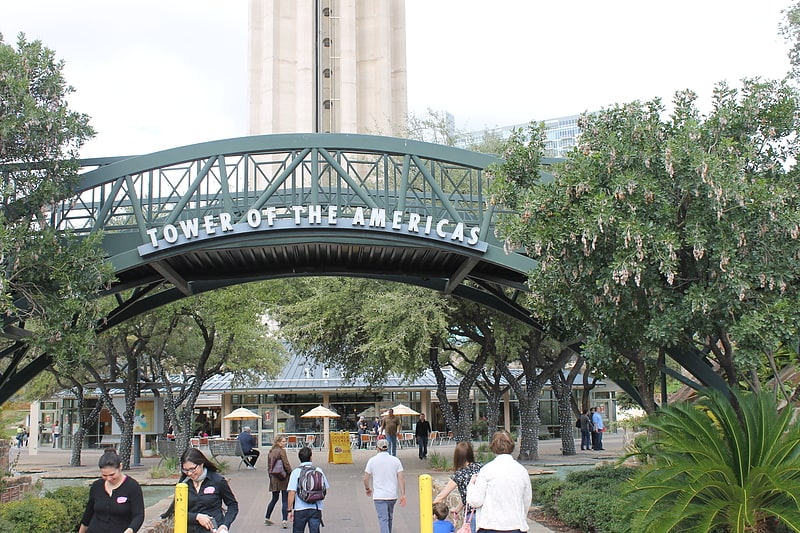
Tower in San Antonio, Texas. The Tower of the Americas is a 750-foot observation tower-restaurant located in the Hemisfair district on the southeastern portion of Downtown San Antonio, Texas, United States. The tower was designed by San Antonio architect O'Neil Ford and was built as the theme structure of the 1968 World's Fair, HemisFair '68. It was named as a result of a name the tower contest created by the executive committee. 68 people submitted the name the tower is now known by.
It was the tallest observation tower in the United States from 1968 until 1996, when the Las Vegas Stratosphere Tower was completed. The tower is the tallest occupiable structure in San Antonio, and it is the 30th-tallest occupiable structure in Texas.
The tower is located in the middle of the former HemisFair '68 site and has an observation deck that is accessible by elevator for a fee. There is also a lounge and revolving restaurant at the top of the tower that provides panoramic views of the city.[4]
Address: 739 E. Cesar E. Chavez Blvd, 78205-3204 San Antonio (Central City)
San Antonio Zoo
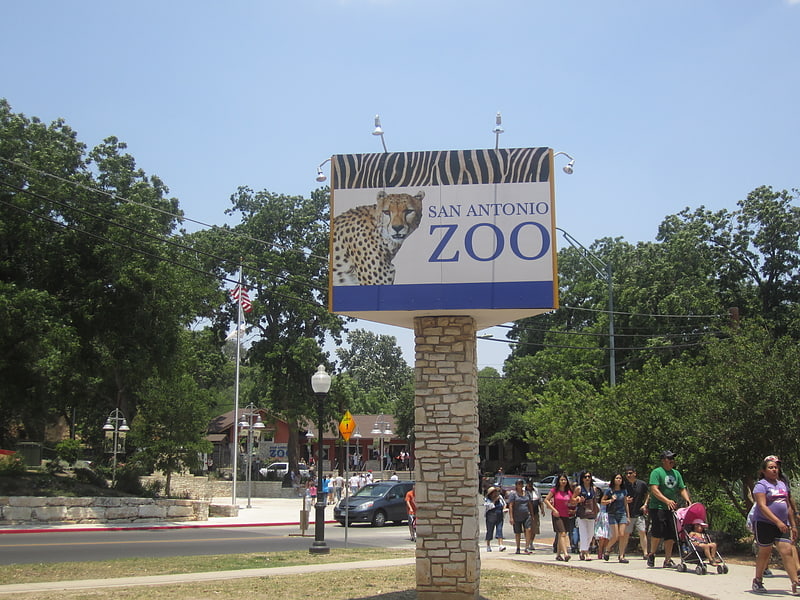
54 acres, 750 species, exhibits and train. The San Antonio Zoo is an Association of Zoos and Aquariums-accredited zoo in Midtown San Antonio, Texas, United States. It is located in the city's Brackenridge Park. San Antonio Zoo is a 50+ acre zoo home to over 750 species, some of which are endangered or extinct in the wild, and an annual attendance of more than 1 million. It also runs non-animal attractions, such as the 2 ft narrow gauge San Antonio Zoo Eagle train ride, which first opened in 1956 and utilizes three Chance Rides C.P. Huntington locomotives.
The Richard Friedrich Aquarium was opened in 1948. It was the only aquarium in the city until SeaWorld San Antonio was opened in 1988.[5]
Address: 3903 N Saint Marys St, 78212-3199 San Antonio (Central City)
San Fernando Cathedral
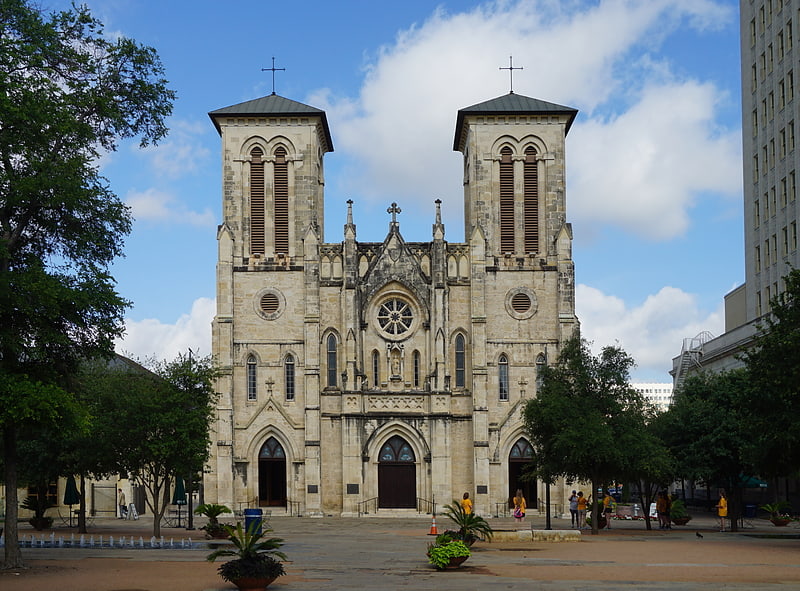
Landmark 1730s Catholic church. San Fernando Cathedral also called the Cathedral of Our Lady of Candelaria and Guadalupe is a cathedral of the Roman Catholic Church located in downtown San Antonio, Texas, United States, facing the city's Main Plaza. It is the mother church of the Archdiocese of San Antonio and the seat of its archbishop. Its dome serves as the city of San Antonio's cultural and geographical center. The cathedral is also known as the Church of Nuestra Señora de la Candelaria y Guadalupe and is listed on the National Register of Historic Places. It is notable as one of the oldest cathedrals in the United States.[6]
Address: 115 Main Plaza, 78205 San Antonio (Central City)
Witte Museum
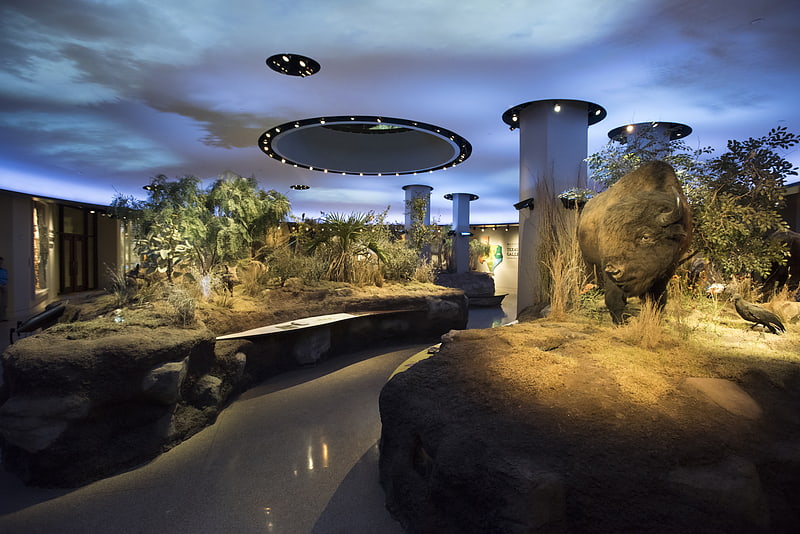
The Witte Museum was established in 1926 and is located in Brackenridge Park in San Antonio, Texas. It is dedicated to telling the stories of Texas, from prehistory to the present. The permanent collection features historic artifacts and photographs, Texas art, textiles, dinosaur bones, cave drawings, and Texas wildlife dioramas, in addition to nationally acclaimed traveling exhibits. Artwork in the collection includes sculpture by San Antonio-born Bonnie MacLeary.
The Witte Museum is named after San Antonio businessman Alfred G. Witte, who bequeathed $65,000 to the city for construction of a museum of art, science, and natural history to be built in memory of his parents. The first Director of the Witte Museum was Ellen Schulz Quillin.[7]
Address: 3801 Broadway St, 78209-6396 San Antonio (Central City)
Market Square

Shopping plaza in San Antonio, Texas. Market Square is a three-block outdoor plaza lined with shops, and restaurants in downtown San Antonio, Texas. Market Square is the largest Mexican market in the United States. The "El Mercado" section has 32 specialty shops and the "Farmer's Market Plaza" section has 80. "Mi Tierra Cafe Y Panaderia" and "La Margarita Mexican Restaurant & Oyster Bar" are the major eateries, but snack and specialty foods are available at other shops. Market Square is the site of Cinco de Mayo in central San Antonio and many other fiestas throughout the year.
The "El Mercado" building was built as a Works Progress Administration project during 1938-1939 after the existing municipal market house (known as the Giles building) was torn down. The new building was originally named the "Municipal Truck Market", but locals commonly called it the "Farmer's Market", as farmers sold their produce straight from their trucks inside the open air building. In 1975, the last produce was sold there, and the market house underwent renovation to convert it into an enclosed air-conditioned mercado.[8]
Address: 514 W Commerce St, 78207-8102 San Antonio (Central City)
San Antonio Japanese Tea Garden

Park in San Antonio, Texas. The San Antonio Japanese Tea Garden, or Sunken Gardens in Brackenridge Park, San Antonio, Texas, opened in an abandoned limestone rock quarry in the early 20th century. It was known also as Chinese Tea Gardens, Chinese Tea Garden Gate, Chinese Sunken Garden Gate and is listed on the U.S. National Register of Historic Places.[9]
Address: 3800 N Saint Marys St, 78212-3170 San Antonio (Central City)
San Antonio Botanical Garden
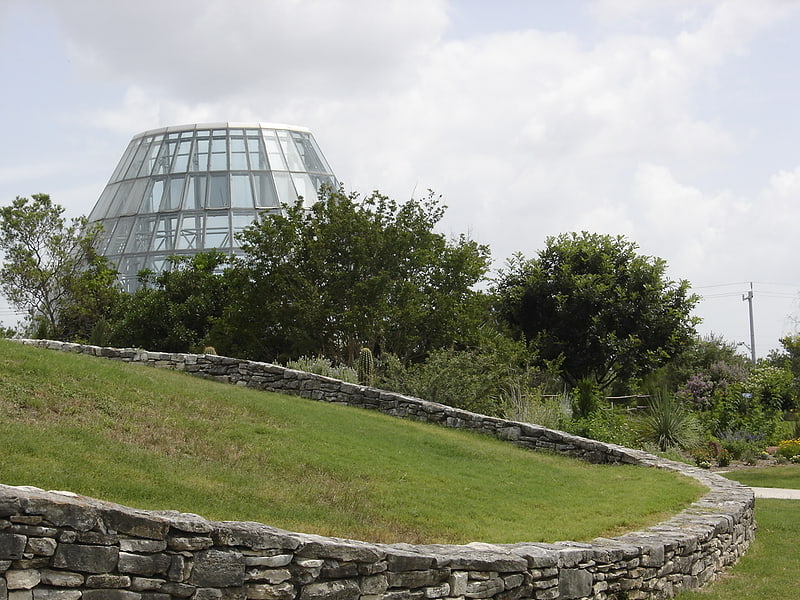
Botanical garden in San Antonio, Texas. The San Antonio Botanical Garden is a 33-acre, non-profit botanical garden in San Antonio, Texas, United States, and the city's official botanical garden.[10]
Address: 555 Funston Pl, 78209-6631 San Antonio (Central City)
Morgan's Wonderland
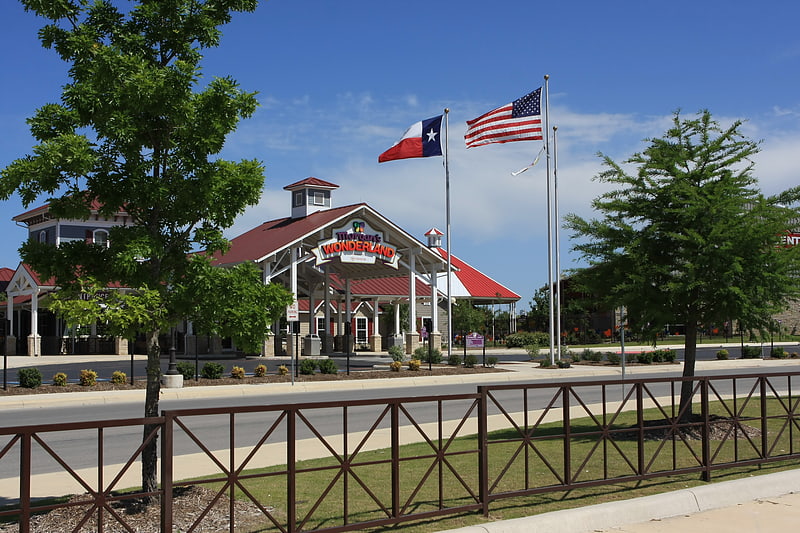
Theme park in San Antonio, Texas. Morgan's Wonderland is a 25-acre non-profit accessible theme park in San Antonio, Texas for guests of all ages and abilities. The park, which opened in 2010 on the site of the former Longhorn Quarry, was developed by Gordon Hartman, a former homebuilder from San Antonio; his daughter Morgan, who deals with cognitive and physical challenges, inspired creation of the park.
Morgan's Wonderland is the first theme park of its kind in the world and has welcomed more than a million guests from all 50 states and 71 countries. Completely wheelchair accessible, the $34 million park features more than 25 elements and attractions including rides, playgrounds, gardens, an 8-acre (3.2 ha) catch-and-release fishing lake, 18,000 sq ft (1,700 m2) special-event center, 575-seat amphitheater, picnic area and rest areas throughout the park.
The organization's mission statement is: “To provide a safe, clean and beautiful environment free of physical and economic barriers that all individuals – regardless of age, special need or disability – can come to and enjoy,” and is often accompanied by the motto, “Where Everyone Can Play!”
Admission for guests with special needs is free; and admission fees for accompanying family members, friends, caregivers and the general public are nominal.[11]
Address: 5223 David Edward Dr, 78233-6941 San Antonio (North San Antonio)
Buckhorn Saloon and Museum

The Buckhorn Saloon & Museum is a privately run museum located at 318 E. Houston Street in Downtown San Antonio, Texas, U.S. Originally privately owned by Albert Friedrich, the Buckhorn became a tourist attraction for its unique collections. Theodore Roosevelt and his Rough Riders were reputed to frequent the establishment. Housed in 1956 in the Lone Star Brewery, the collection passed to Friedrich's heirs who had it moved to its current location.[12]
Address: 318 E Houston St, 78205 San Antonio (Central City)
La Antorcha de la Amistad

Sculpture by Sebastián. La Antorcha de la Amistad is a monumental abstract sculpture by Mexican sculptor Sebastián, installed in Downtown San Antonio, in the U.S. state of Texas. The work was commissioned by a group of Mexican businessmen living in the United States and friends of Mexico, and presented as a gift from the Mexican government to the City of San Antonio in 2002. It was unveiled on June 27, 2002, by the artist, Mayor Edward D. Garza, and then–Secretary of Foreign Affairs for Mexico and political analyst Jorge Castañeda Gutman.[13]
San Jose Mission
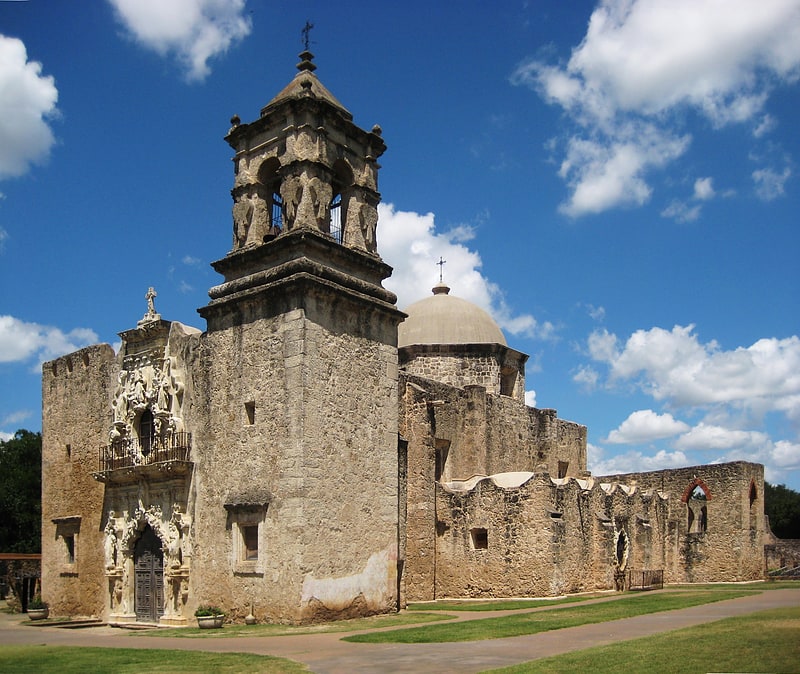
Building in San Antonio, Texas. Mission San José y San Miguel de Aguayo is an historic Catholic mission in San Antonio, Texas, United States. The mission was named in part for the Marquis de San Miguel de Aguayo, José de Azlor y Virto de Vera. Many buildings on the campus of Texas Tech University in Lubbock, Texas, borrow architectural elements from those found at Mission San José.
The mission was founded on February 23, 1720, because Mission San Antonio de Valero had become overcrowded shortly after its founding with refugees from the closed East Texas missions. Father Antonio Margil received permission from the governor of Coahuila and Texas, the Marquis de San Miguel de Aguayo, to build a new mission 5 miles (8 km) south of San Antonio de Valero. Like San Antonio de Valero, Mission San José served the Coahuiltecan Natives. The first buildings, made of brush, straw, and mud, were quickly replaced by large stone structures, including guest rooms, offices, a dining room, and a pantry. A heavy outer wall was built around the main part of the mission, and rooms for 350 Natives were built into the walls.
A new church, which is still standing, was constructed in 1768 from local limestone. The mission lands were given to its Natives in 1794, and mission activities officially ended in 1824. After that, the buildings were home to soldiers, the homeless, and bandits. Starting in 1933, the Civil Works Administration and then the Works Progress Administration provided the labor to rebuild and restore the grounds of the mission. Some of the funding for the restoration came from money allotted by the United States for the Texas Centennial Exposition held in Dallas in 1936. The mission walls and Indian quarters were re-built, and the granary was restored.
The church facade features from the top: a cross, representing Jesus Christ, St. Joseph (San José) holding the infant Jesus, St. Dominic and St. Francis, Our Lady of Guadalupe (the Virgin Mary), and St. Joachim and St. Anne holding the infant Mary. Located at the south wall of the church sacristy is the Rose Window. Sculptor and significance of the Rose Window is unknown. According to folklore, the window was sculpted by a Spanish master craftsman and artist Pedro Huizar and dedicated it to his sweetheart Rosa who, on her way from Spain to meet with Pedro, lost her life at sea. The Rose Window was sculpted in 1775 and is an example of Baroque architecture in America.
Mission San José is now part of the San Antonio Missions National Historical Park. In 2015, along with The Alamo and Mission Concepción, it became one of five missions in San Antonio designated a World Heritage Site by the United Nations Education, Scientific and Cultural Organization.
Today the mission is an active parish, and is staffed by the Order of Friars Minor. The current pastor is Fr. Rogelio Martinez, OFM.[14]
Address: 6701 San Jose Dr, San Antonio (Central City)
Steel Eel
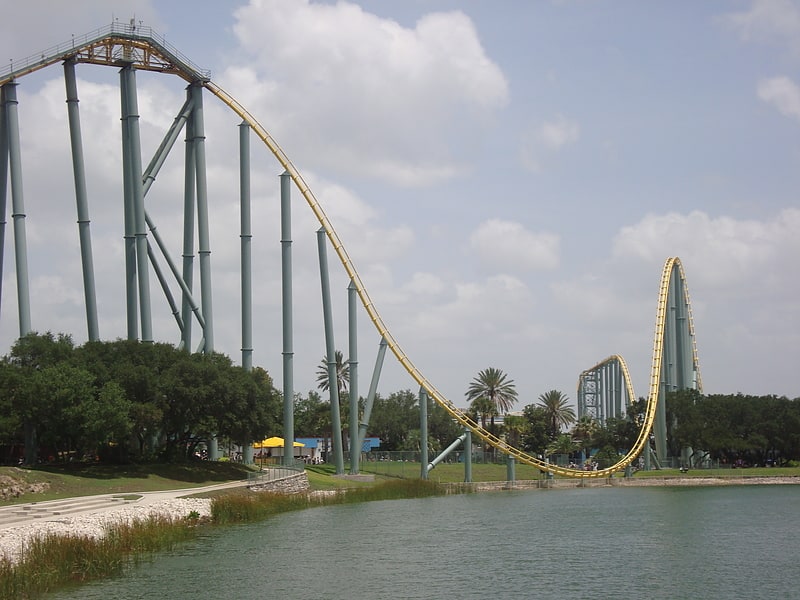
Roller coaster. Steel Eel is a custom roller coaster built by D. H. Morgan Manufacturing. At a height of 150 feet, Steel Eel is the tallest roller coaster at SeaWorld San Antonio and was the second coaster built by SeaWorld, following The Great White, after new management felt the park needed to offer more thrilling rides. Steel Eel had to be custom built to fit along the slim area beside the lake and utilizes a simple lap bar and seatbelt restraint system. Key elements of Steel Eel include two hills after the lift hill with a small valley between the two and a diving dogleg turn and triple humpback hills after its mid-course brake run. With a paint scheme consisting of bright yellow track and violet supports, it has become a permanent staple in the park's skyline.
The coaster got a new coat of purple and yellow paint for 2019 season.[15]
Address: 10500 Sea World Dr, 78251 San Antonio (West San Antonio)
AT&T Center

The AT&T Center is a multi-purpose indoor arena on the east side of San Antonio, Texas, United States. It is the home of the San Antonio Spurs of the National Basketball Association.
The arena seats 18,418 for basketball, and 19,000 for concerts or gatherings, and contains 2,018 club seats, 50 luxury suites and 32 bathrooms. It was opened in 2002 as the SBC Center, at a cost of US$175 million, financed by county-issued bonds, which were supported by a hotel-occupancy and car-rental tax increase and an additional contribution of $28.5 million from the Spurs. SBC Communications, Inc. purchased the naming rights to the facility under a 20-year, $41 million naming rights agreement with Bexar County, the San Antonio Spurs, and the San Antonio Stock Show & Rodeo in July 2000. SBC Communications changed its name to AT&T Inc. in November 2005. The arena officially changed its name to AT&T Center in January 2006. On July 2, 2021, it was announced that AT&T will not renew its contract for the name at the venue, meaning that a new name could come soon as the deals ends in fall 2022.
From 2003 to 2017, the arena was home to the San Antonio Stars of the Women's National Basketball Association. It was the home of the San Antonio Rampage of the American Hockey League from 2002 until 2020.[16]
Military Working Dog Teams National Monument
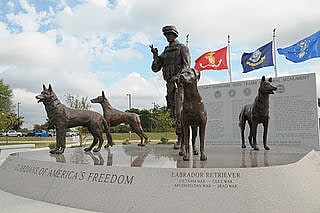
Monument in Bexar County, Texas. The Military Working Dog Teams National Monument is a monument to military working dogs located at Joint Base San Antonio -Lackland in San Antonio, Texas. The monument represents handlers, dogs, and veterinary support, from all military service branches that have made up the Military Working Dog program since World War II. The monument grounds include a 3,000 square feet granite plaza, granite pedestals, granite history wall, granite benches and water fountain. The granite pedestals have large bronze statues of dogs and handlers. The monument was dedicated on October 28, 2013.[17]
Address: Joint Base San Antonio-Lackland, 78236 San Antonio (Southwest San Antonio)
Mission San Francisco De La Espada Catholic Church

Catholic church in San Antonio, Texas. Mission San Francisco de la Espada is a Roman Rite Catholic mission established in 1690 by Spain and relocated in 1731 to present-day San Antonio, Texas, in what was then known as northern New Spain. The mission was built in order to convert local Native Americans to Christianity and solidify Spanish territorial claims in the New World against encroachment from France. Today, the structure is one of four missions that comprise San Antonio Missions National Historical Park.[18]
Mission Concepción
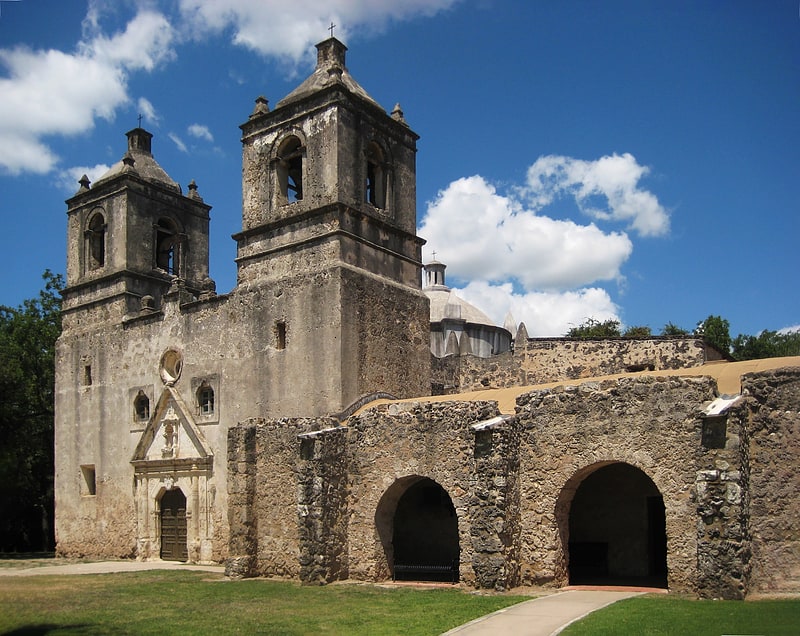
Catholic church in San Antonio, Texas. Franciscan Friars established Mission Nuestra Señora de la Purísima Concepción de Acuña in 1711 as Nuestra Señora de la Purísima Concepción de los Hainais in East Texas. The mission was established by the Domingo Ramón-St. Denis expedition and was originally meant to be a base for converting the Hasinai to Catholicism and teaching them what they needed to know to become Spanish citizens. The friars moved the mission in 1731 to San Antonio. After its relocation most of the people in the mission were Pajalats who spoke a Coahuiltecan language. Catholic Mass is still held every Sunday.
On October 28, 1835, Mexican troops under Colonel Domingo de Ugartechea and Texian insurgents led by James Bowie and James Fannin fought the Battle of Concepción here. Historian J.R. Edmondson describes the 30-minute engagement as "the first major engagement of the Texas Revolution."
Mission Concepción is the oldest unrestored stone church in America. it was designated a National Historic Landmark on April 15, 1970 and is part of San Antonio Missions National Historical Park. In 2015, the United Nations Educational, Scientific, and Cultural Organization designated Concepción and four other San Antonio missions, including The Alamo, as a World Heritage Site, the first in Texas and one of twenty-three such establishments in the United States.
Mission Concepción consists of a sanctuary, nave, convento, and granary. When originally built, brightly painted frescos decorated both the exterior and interior of the building. Traces of the frescoes still exist on the weathered facade of the building. Experts restored some of the artwork on the interior ceilings and walls of the convento in 1988. The Archdiocese of San Antonio completed another restoration of the mission's interior in 2010 which exposed more frescoes in the sanctuary and nave.[19]
McNay Art Museum
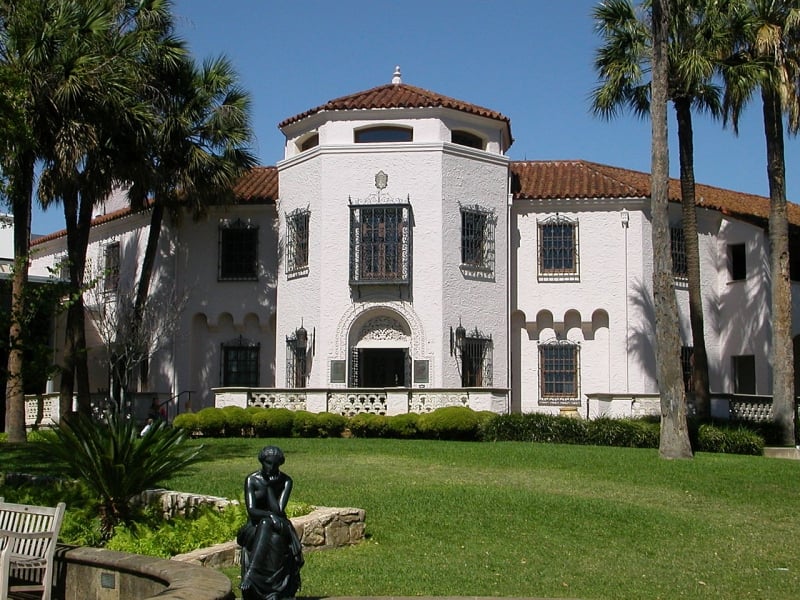
Museum. The McNay Art Museum, founded in 1954 in San Antonio, is the first modern art museum in the U.S. state of Texas. The museum was created by Marion Koogler McNay's original bequest of most of her fortune, her important art collection and her 24-room Spanish Colonial Revival-style mansion that sits on 23 acres that are landscaped with fountains, broad lawns and a Japanese-inspired garden and fishpond.
McNay was an American painter and art teacher who inherited a substantial oil fortune upon the death of her father. The museum was named after her, and has been expanded to include galleries of medieval and Renaissance artwork and a larger collection of 20th-century European and American modernist work. She built a home in 1927 designed by Atlee Ayres and his son Robert M. Ayres. Upon her death, the house was bequeathed to the City of San Antonio to house the museum.
The museum focuses primarily on 19th- and 20th-century European and American art by such artists as Paul Cézanne, Pablo Picasso, Paul Gauguin, Henri Matisse, Georgia O'Keeffe, Diego Rivera, Mary Cassatt, and Edward Hopper. The collection today consists of over 20,000 objects and is one of the finest collections of contemporary art and sculpture in the Southwestern United States. The museum also is home to the Tobin Collection of Theatre Arts, which is one of the premiere collections of its kind in the U.S. and a research library with over 30,000 volumes.
The McNay Art Museum added the Jane and Arthur Stieren Center for Exhibitions in 2008, built by internationally renowned architect Jean-Paul Viguier, to display their Modern collection. The 45,000-square-foot structure houses light-filled galleries for special exhibitions, a glass-fronted gallery for sculpture from the museum's collection, a gallery for paper works, wall cases for small objects, and state-of-the-art lecture hall and learning centers. The Center's elegant design, rich materials, and architectural details both contrast with and complement the original Spanish Colonial Revival-style residence, which it adjoins.[20]
Address: 6000 N New Braunfels Ave, 78209-4618 San Antonio (Central City)
San Antonio Museum of Art
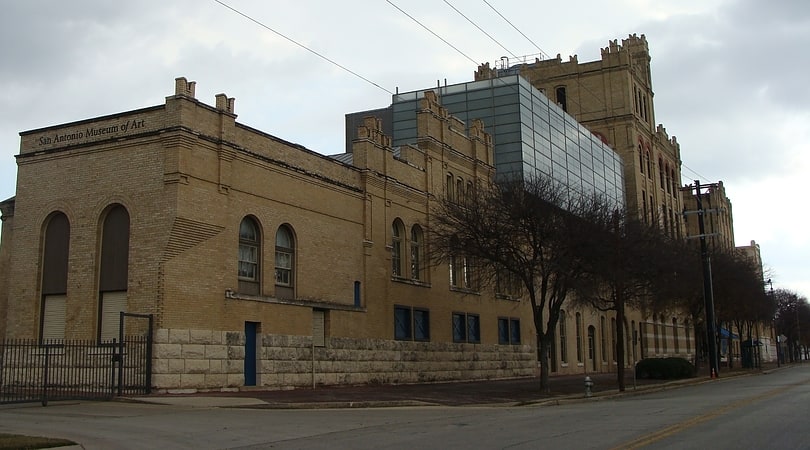
Works from Egyptian to Latin-American. The San Antonio Museum of Art is an art museum in Downtown San Antonio, Texas, USA. The museum spans 5,000 years of global culture. The Museum is housed in the historic former Lone Star Brewery on the Museum Reach of the San Antonio River Walk. Following a $7.2 million renovation, it opened to the public in March 1981.[21]
Address: 200 W Jones Ave, 78215-1402 San Antonio (Central City)
Majestic Theatre

Theatre in San Antonio, Texas. The Majestic Theatre is San Antonio's oldest and largest atmospheric theatre. The theatre seats 2,264 people and was designed by architect John Eberson, for Karl Hoblitzelle's Interstate Theatres in 1929.
In 1975, the theatre was listed on the National Register of Historic Places and was designated a Texas Historic Landmark in 1991 and a National Historic Landmark April 19, 1993. The theatre was home to the San Antonio Symphony from 1989 to 2014. For many years, it remained the largest theatre in Texas and the second largest movie theatre in the United States. It was also the first theatre in the state to be totally air-conditioned.[22]
Address: San Antonio, 224 E. Houston Street
St. Joseph Catholic Church
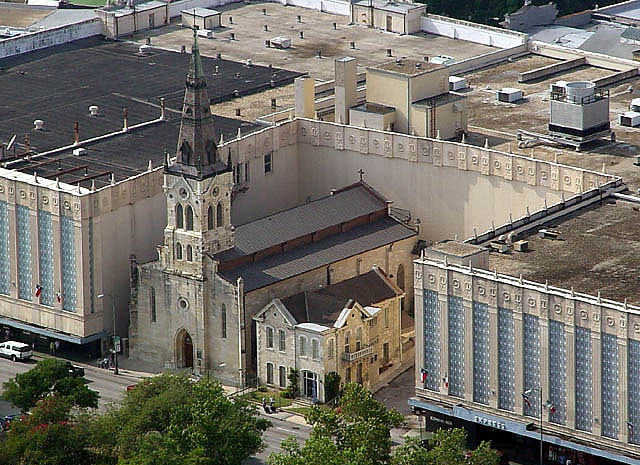
Church in San Antonio, Texas. The St. Joseph Catholic Church is a Roman Catholic parish church in the Roman Catholic Archdiocese of San Antonio, located at 623 East Commerce Street in downtown San Antonio, Texas, United States. The Gothic Revival house of worship was the fourth Catholic parish in the city.
The church is an example of what the Chinese describe as a nail house; when the church refused to sell to a property developer, a large shopping mall was constructed around it.[23]
Address: 623 E Commerce St, 78205-2619 San Antonio (Central City)
Spanish Governor's Palace
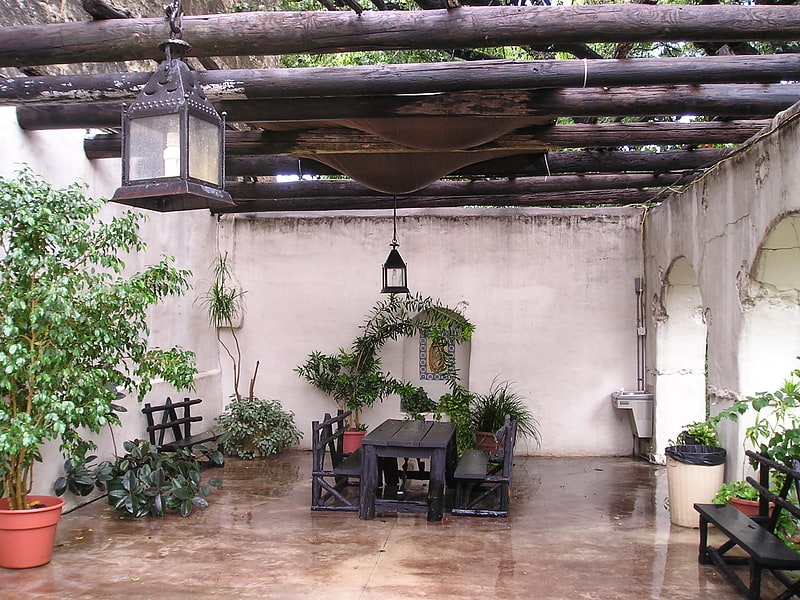
Museum in San Antonio, Texas. The Spanish Governor's Palace is a historic adobe from the Spanish Texas period located in Downtown San Antonio.
It is the last visible trace of the 18th-century colonial Presidio San Antonio de Béxar complex, and the only remaining example in Texas of an aristocratic 18th-century Spanish Colonial in−town residence. The National Geographic Society has named the landmark "the most beautiful building in San Antonio." The building was designated a National Historic Landmark in 1970. It is now owned by the city, and is open to the public as a museum.[24]
Address: 105 Plaza de Armas, 78205-2412 San Antonio (Central City)
Nelson W. Wolff Municipal Stadium
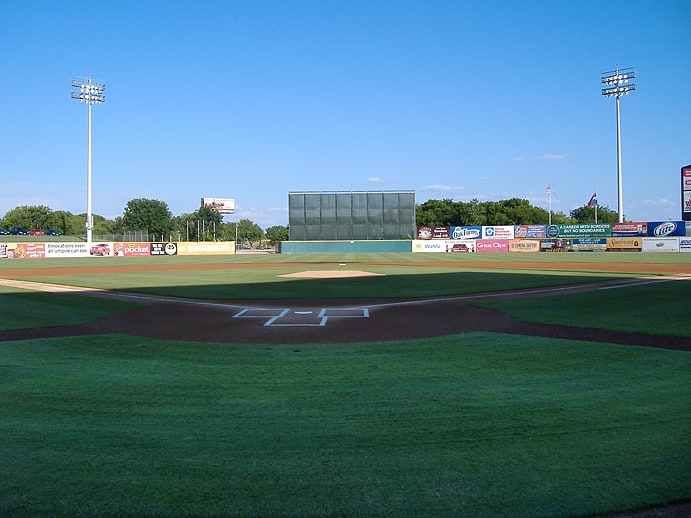
Stadium in San Antonio, Texas. Nelson W. Wolff Municipal Stadium is a stadium in San Antonio, Texas, United States. It is primarily used for baseball, and is the home field of the San Antonio Missions Minor League Baseball team of the Double-A Central. The UTSA Roadrunners baseball team also plays some home games at the stadium. The stadium is named for Bexar County Judge Nelson Wolff, who is a former Texas legislator and San Antonio councilman and mayor.
The Wolff is located about 8 miles (13 km) to the west of Downtown San Antonio. It was opened on April 18, 1994, (as the San Antonio Municipal Stadium) and has 6,200 fixed seats and a grass berm in left field that can seat about 3,000. The stadium features 14 luxury suites, a 500-person picnic area down the right field line, and an all-you-can-eat-and-drink fiesta deck that can be rented for groups of 25 to 200 people. The dimensions (from home plate to the outfield wall) are: 310 feet (94 m) to left field, 402 feet (123 m) to center field, and 340 feet (100 m) to right field.[25]
Address: 5757 Highway 90 West, 78227 San Antonio (West San Antonio)
Freeman Coliseum
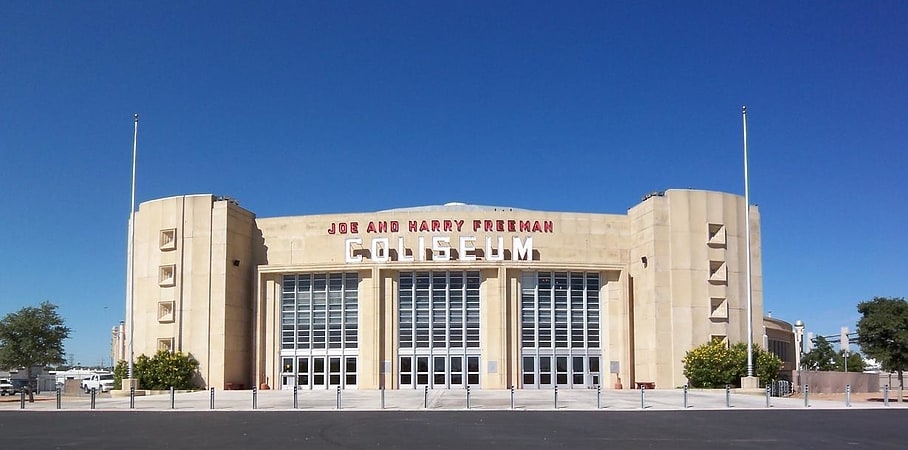
Sports venue in San Antonio, Texas. Freeman Coliseum is a sports and concert venue located in San Antonio, Texas. It has been host to thousands of events including the San Antonio Stock Show & Rodeo, concerts, trade shows, motor sports, circus, professional sports including professional bull riding, basketball, hockey, boxing and wrestling. It was the largest indoor arena in San Antonio until HemisFair Arena opened in 1968. Since then, many top recording artists have made their San Antonio concert debuts at the Coliseum.
Freeman Coliseum was the home of the San Antonio Stock Show & Rodeo until the opening in 2003 of the adjacent AT&T Center, formerly known as SBC Center. Although the main rodeo event is now in AT&T Center, stock show and exhibit aspects of the rodeo are still held in the Coliseum. The 2021 Rodeo was held in the Freeman due to the COVID-19 Pandemic. The WNBA's San Antonio Stars played its home games at Freeman Coliseum during the 2015 season due to renovations at AT&T Center. The Coliseum was home to the San Antonio Rowels and its national team rodeo league competition, as well as two professional hockey teams: the Central Hockey League San Antonio Iguanas and later, the International Hockey League San Antonio Dragons from 1996 to 1998.
Freeman Coliseum seats 9,500 for motor sports, rodeos and professional bull riding; 9,800 for basketball and up to 11,700 for concerts, boxing and wrestling. It contains a 77-foot (23 m) ceiling height. When used for trade shows, the arena features 31,250 square feet (2,903 m2) of space, plus 129,500 square feet (12,030 m2) of exhibit space in four adjacent exhibit halls—the 60,000-square-foot (6,000 m2) Morris Center, the 36,000-square-foot (3,300 m2) Exhibit Hall #1, the 20,000-square-foot (2,000 m2) Freeman Building and the 13,500-square-foot (1,250 m2) Exhibit Hall #2.[26]
Address: 3201 E Houston St, 78219-3707 San Antonio (Central City)
Basilica of the National Shrine of the Little Flower
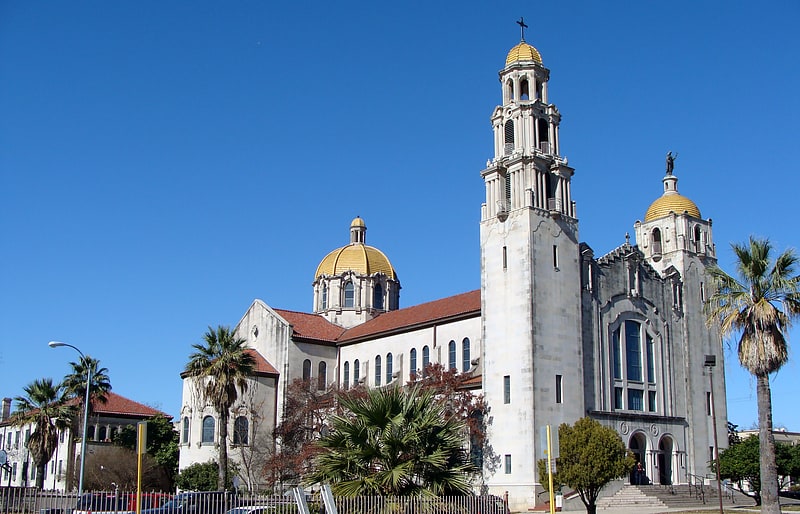
Church in San Antonio, Texas. The Basilica of the National Shrine of the Little Flower also called Our Lady of Mount Carmel and St. Thérèse Church is a historic Roman Catholic church, located in San Antonio, Texas, in the United States. The church is distinguished as one of 84 in the United States bearing the papal designation of "minor basilica." Despite its religious importance it is not the cathedral of the local diocese; that distinction belongs to San Fernando Cathedral.[27]
Address: 1715 N Zarzamora St, 78201 San Antonio (Central City)
Artpace
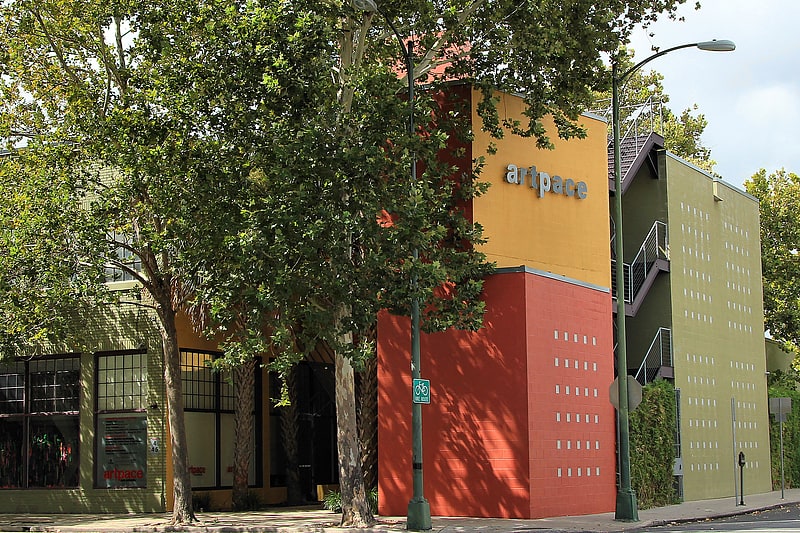
Art gallery in San Antonio, Texas. Artpace is a non-profit contemporary art gallery located in San Antonio, Texas, United States, founded by Linda Pace. Artpace opened its doors in 1995, and focuses on the artistic process. Occupying the space of a former Hudson automobile dealership, Artpace uses its industrial space as the setting for its programs and events.[28]
Address: 445 N. Main Ave., 78205-1441 San Antonio (Central City)
Alamo Cenotaph
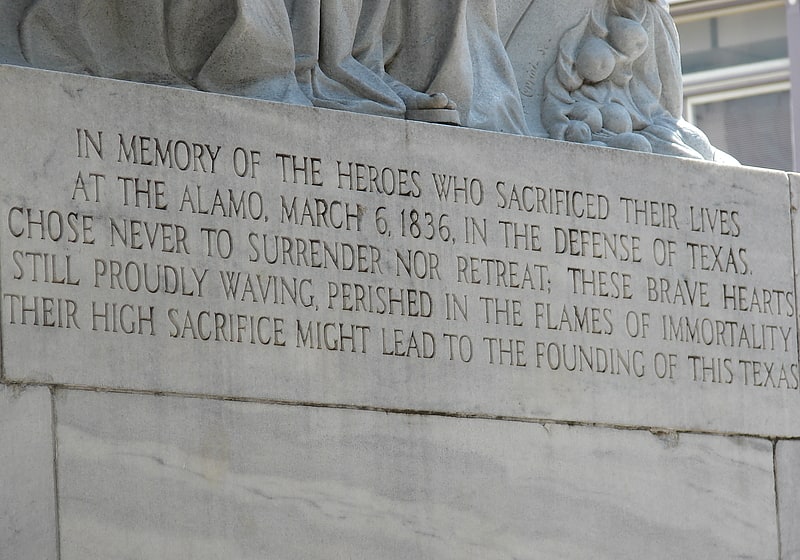
Monument in San Antonio, Texas. The Alamo Cenotaph, also known as The Spirit of Sacrifice, is a monument in San Antonio, Texas, United States, commemorating the Battle of the Alamo of the Texas Revolution, which was fought at the adjacent Alamo Mission. The monument was erected in celebration of the centenary of the battle, and bears the names of those known to have fought there on the Texas side.[29]
Address: 300 Alamo Plz, San Antonio (Central City)
SeaWorld

Amusement park, Water park, Theme park
Address: 10500 Sea World Dr, 78251-3001 San Antonio (West San Antonio)
Arneson River Theater
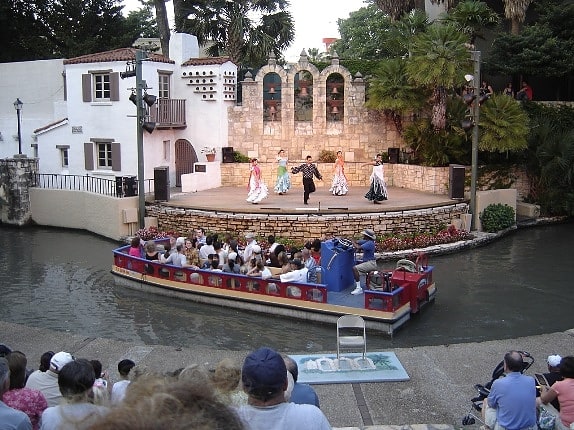
Theater in San Antonio, Texas. Arneson River Theatre is an outdoor performance theater located on the San Antonio River Walk in the U.S. state of Texas.
The open-air venue was erected 1939-1941 by the Works Progress Administration. The design was supervised by architect Robert H.H. Hugman. It is named after Edwin P. Arneson, the regional engineer for the W.P.A. who was instrumental in securing funding for the Paseo del Rio. Arneson died before construction began. Many years later bells were added to arches behind the stage that Hugman had designed, and they were named for him. In a belated ceremony, the "Father of the River Walk" struck the bells for the first time, two years before his death.
The stage is on the north side of river; the audience sits on the grass-covered steps on the south side, which can hold over 800 people on 13 rows of seats. A nearby stone bridge is often made part of the performance space. It is now called Rosita's Bridge in honor of Rosita Fernández, a pioneer of Tejano music, who performed here as star of the summer-long Fiesta Noche del Rio for 25 years. The theater continues to be used throughout the year for a wide variety of performances averaging over 200 each year including folkloric groups, festivals, music concerts, plays, dance, opera, and even weddings. Many of the river parades held throughout the year are televised from this unique open-air amphitheater.
Above and behind the seating area is La Villita Historic Arts Village, a restoration of San Antonio's oldest residential neighborhood, today filled with artisan shops, galleries, and restaurants.
The theater, along with several other San Antonio landmarks, was featured in the popular 2000 comedy film Miss Congeniality, starring Sandra Bullock and Michael Caine.[30]
Address: 418 Villita St, 78205 San Antonio (Central City)
Aztec Theatre

Theater. The Aztec Theatre is a historic theater in Downtown San Antonio, Texas, US.[31]
Address: San Antonio, 104 N St Mary's St, San Antonio, TX 78205-2209
La Villita
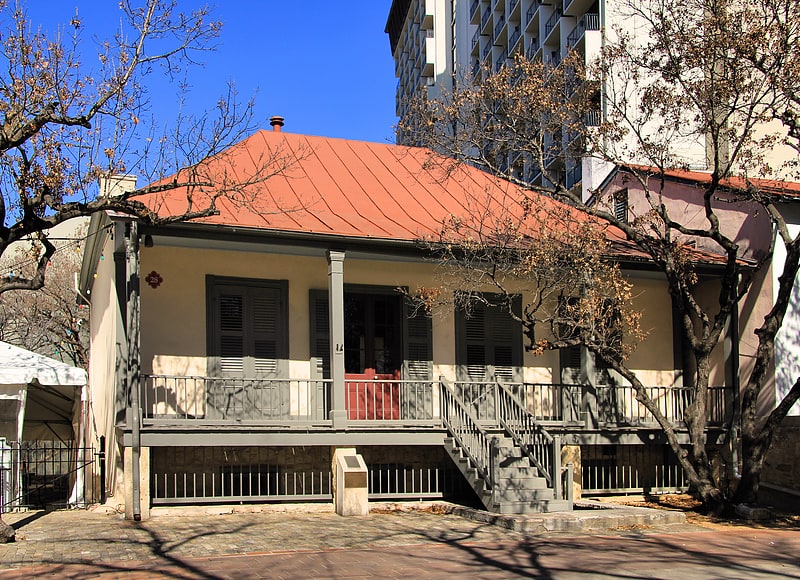
Historical place in San Antonio, Texas. The Jeremiah Dashiell House is located in the Bexar County city of San Antonio in the U.S. state of Texas. Also known as Casa Villita, it was designated a Recorded Texas Historic Landmark under that name in 1962. It is listed on the National Register of Historic Places listings in Bexar County, Texas as a contributing structure of the La Villita Historic District.[32]
Address: 418 Villita St, 78205-2908 San Antonio (Central City)
San Pedro Springs Park
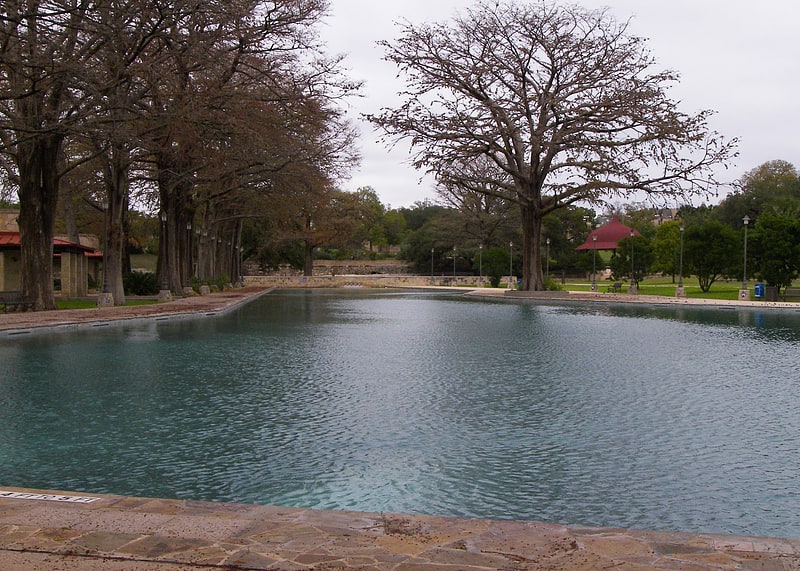
Park in San Antonio, Texas. San Pedro Springs Park is located in the Bexar County city of San Antonio in the U.S. state of Texas. Surrounding the source of the springs, the 46-acre park is the oldest in the state of Texas. It is the location of a Payaya Indian village known as Yanaguana, and is the original site of the city of San Antonio. The park is alternately known as San Pedro Park. The park was designated a Recorded Texas Historic Landmark in 1965. It was added to the National Register of Historic Places listings in Bexar County, Texas on November 1, 1979. Although it is often stated that it is the second oldest city park in the United States after Boston Common, it is at most the tenth oldest after Plaza de la Constitución in San Augustine, Florida among others.[33]
Address: 1315 San Pedro Ave, 78212-4202 San Antonio (Central City)
San Antonio River Walk
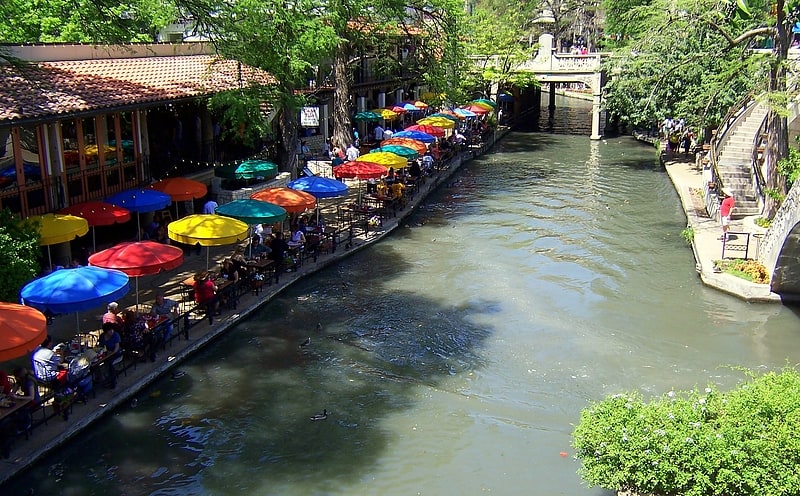
Park in San Antonio, Texas. The San Antonio River Walk is a city park and special-case pedestrian street in San Antonio, Texas, one level down from the automobile street. The River Walk winds and loops under bridges as two parallel sidewalks lined with restaurants and shops, connecting the major tourist draws from the Shops at Rivercenter, to the Arneson River Theatre, to Marriage Island, to La Villita, to HemisFair Park, to the Tower Life Building, to the San Antonio Museum of Art, to the Pearl and the city's five Spanish colonial missions, which have been named a World Heritage Site, which includes the Alamo. During the annual springtime Fiesta San Antonio, the River Parade features flowery floats that float down the river.[34]